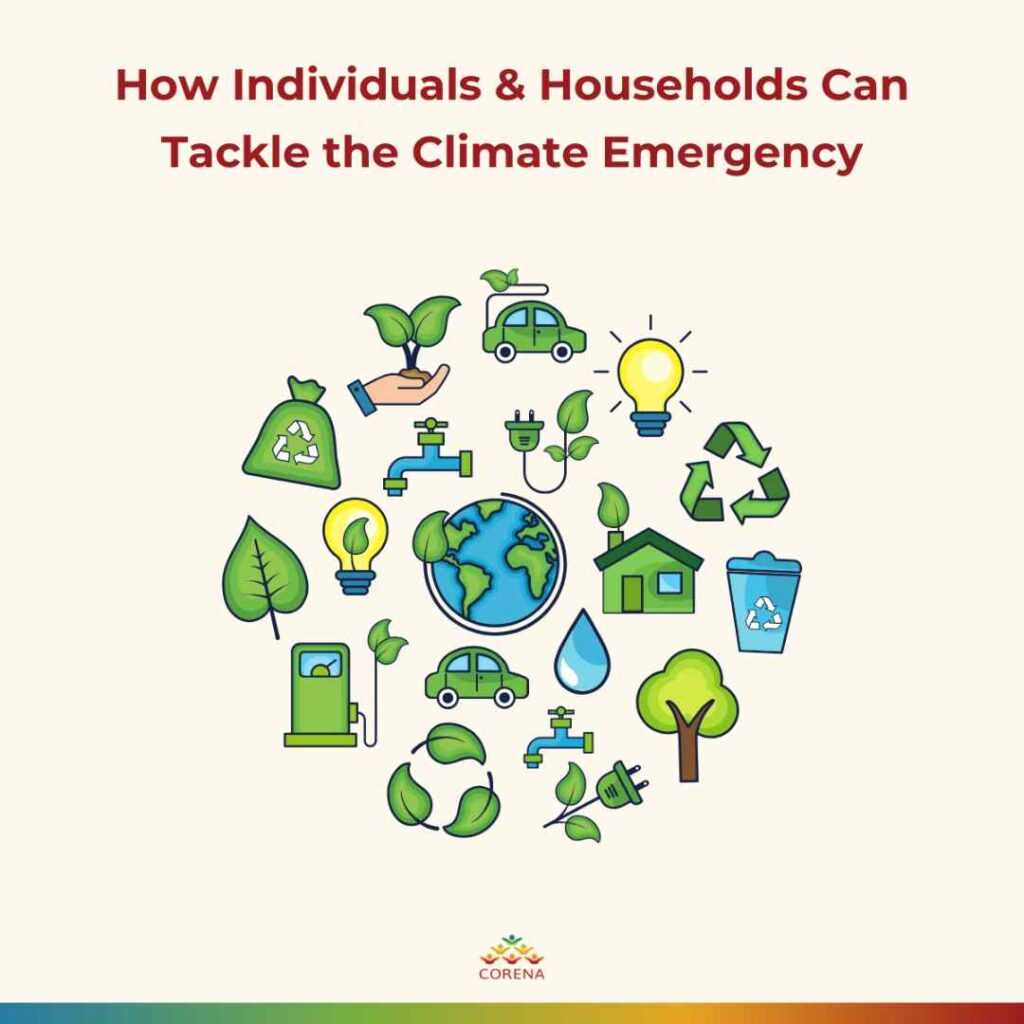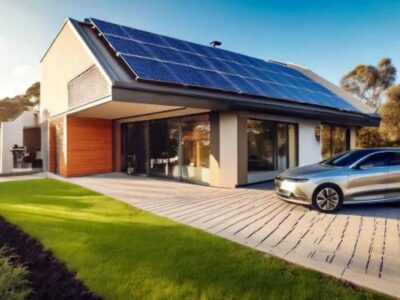The climate emergency is a stark reality, its effects rippling across the globe in the form of extreme weather events, rising sea levels, and disrupted ecosystems. While governments and industries have a crucial role to play in taking climate action the collective efforts of individuals and households are equally vital. We, as consumers and members of communities, hold significant power to make a difference. By embracing sustainable practices and investing in eco-friendly technologies and decarbonisation initiatives, we can significantly reduce our carbon footprint, contribute to the goal of net zero, and help foster a healthier planet.
CORENA has traditionally focused on educating and supporting other non profits to make a difference. Due to recent developments around the world we thought it is now even more important to outline practical ways households and individuals can also play their part in tackling the climate emergency, focusing on key areas where we can all make a real impact.

How Individuals & Households Can Take Climate Action
1. Harnessing the Sun: The Power of Solar Panels
One of the most impactful steps a household can take is installing solar panels. These photovoltaic systems convert sunlight directly into electricity, providing a clean and renewable energy source. By generating your own clean energy , you reduce your reliance on fossil fuel-based electricity from the grid, lowering your carbon footprint and potentially saving money on your energy bills in the long run. The initial investment in solar panels can seem daunting, but government incentives, rebates, and feed-in tariffs (where you can sell excess energy back to the grid) can significantly offset the costs. Furthermore, the long-term electricity bill savings and the environmental benefits make solar panels a worthwhile investment for a sustainable future. Before installing solar, it’s essential to assess your roof’s suitability (orientation and angle), research reputable installers, and compare different panel, inverter and possibly battery options to find the best fit for your needs and budget.
Learn more in Why Solar Panels Are A Top Renewable Energy Source
2. Warm and Cool Efficiently : Embracing Heat Pumps
Heating and cooling account for a significant portion of household energy consumption. Traditional heating systems, often reliant on gas or electricity generated from fossil fuels, contribute substantially to greenhouse gas emissions. Heat pumps (otherwise known as reverse cycle or split system air conditioners) offer a much more sustainable alternative. These ingenious devices transfer heat from the outside air (or ground) into your home, providing energy efficient heating in winter and cooling in summer. Heat pumps use significantly less energy than conventional heating systems, resulting in lower energy bills and a reduced carbon footprint. Consulting with a qualified HVAC professional can help you determine the best heat pump solution for your climate and home.
Learn more in Heat Pumps Guide for Non Profits
3. Illuminating the Future: Energy-Efficient Lighting
Switching to energy-efficient lighting is a simple yet effective way to reduce your energy consumption and carbon footprint. Halogen and incandescent lighting is notoriously inefficient, wasting a significant amount of energy as heat. LED (Light Emitting Diode) bulbs, on the other hand, are incredibly energy-efficient, using up to 80% less energy than incandescent bulbs and lasting much longer. While LED bulbs might have a higher upfront cost, their longevity and energy savings make them a cost-effective choice in the long run. Replacing all the bulbs in your home with LEDs is a quick and easy way to make a tangible difference in your energy consumption and contribute to a more sustainable future.
Learn more in Lightbulb Moment: Energy-Efficient & Sustainable Lighting Solutions Guide
4. Sustainable Hot Water: Green Solutions
Hot water accounts for a considerable portion of household energy use. Traditional hot water systems, often powered by gas or electricity, contribute to greenhouse gas emissions. Fortunately, several green hot water solutions are available. Heat pump water heaters, similar to heat pumps for home heating, are highly efficient and can significantly reduce energy consumption compared to conventional systems. Solar hot water systems, which utilise solar panels to heat water, are another excellent option, particularly in sunny climates. These systems can significantly reduce or even eliminate your reliance on grid electricity for hot water. You can also connect an existing electric water heater to operate exclusively on daytime solar. When choosing a hot water solution, consider your climate, budget, and energy consumption patterns to find the most sustainable and cost-effective solution for your household. Also make sure not to oversize it, plus don’t have the thermostat (temperature) set too high – otherwise you are using excess energy to heat a lot of hot water that is never being used.
Learn more in Green & Energy Efficient Water Heating Guide For Non Profits
5. Cooking with Efficiency: Induction Stovetops
Induction stovetops are a game-changer in the kitchen when it comes to energy efficiency and precise cooking. Unlike traditional electric or gas stovetops, induction cooking uses electromagnetic fields to directly heat the cookware itself, rather than heating the stovetop surface. This results in faster heating, more precise temperature control, and significantly less energy waste. Induction stovetops are also safer to use, as the stovetop surface itself doesn’t get hot, reducing the risk of burns. While the initial cost of an induction stovetop might be higher, the energy savings and improved cooking experience make it a worthwhile investment for a sustainable kitchen.
Learn more in Induction Stovetops Guide for Non Profits
6. Keeping it Cozy: The Importance of Insulation
Proper insulation is crucial for maintaining a comfortable temperature in your home and reducing energy waste. A well-insulated home keeps heat in during the winter and keeps it out during the summer, reducing the need for heating and cooling. This translates to lower energy bills and a smaller carbon footprint. Insulating your roof, walls, and floors can significantly improve your home’s energy efficiency. Different types of insulation are available, including fiberglass, cellulose, and spray foam. Using external awnings to block the summer sun (esp the afternoon sun) from entering the home will also help to keep it cooler in summer. Consulting with a professional can help you determine the best insulation solution for your home and climate.
7. Driving Towards a Greener Future: Electric Vehicles
Transportation is a major contributor to greenhouse gas emissions. Switching to an electric vehicle (EV) is a significant step towards reducing your carbon footprint and contributing to a cleaner transportation sector. EVs produce less greenhouse gas emissions, and if charged from a solar system there are zero emissions. They also produce zero tailpipe emissions, reducing local air pollution and its health impacts. While the initial cost of an EV might be higher than a petrol or diesel powered car, government incentives, tax credits, and lower running costs (due to cheaper electricity compared to petrol or diesel) can make EVs a more affordable option in the long run. Furthermore, the vast majority of owners can charge their EV at home, plus charging infrastructure for EVs is constantly improving making them a practical choice for even long-distance travel. By choosing an EV, you’re not only reducing your personal carbon footprint but also supporting the transition to a more sustainable transportation system.
Learn more in Electric Vehicles Guide for Non Profits
8. Investing in a Sustainable Future: Socially Responsible Superannuation
For Australians, superannuation is an important long-term investment and a lot of us already have significant amounts of money held in these funds as a result of compulsory employer contributions. By choosing a socially responsible superannuation fund, you can ensure that your retirement savings are invested in companies that are actively contributing to a sustainable future and avoiding those that are detrimental to the environment. Socially responsible funds prioritise investments in renewable energy solutions, sustainable technologies and innovations, and companies with strong environmental, social, and governance (ESG) practices. They also actively exclude investments in industries that contribute to the climate emergency, such as fossil fuels as well as other unethical industries such as tobacco and weapons manufacturing. Researching and switching to a socially responsible superannuation fund is a powerful way to align your investments with your values and contribute to a more sustainable future while you build your retirement nest egg.
9. Help Non Profits & Community Organisations: Donate to a Renewable Energy & Climate Charity
Here at CORENA, we provide an innovative revolving fund model that helps finance non profit and community organisations who wish to reduce their carbon footprint and improve their energy efficiency, but cannot afford the upfront expense. Our fund ensures that these kinds of climate projects get the funding that they need in order to get off the ground and become part of the renewable energy transformation.
Through offering a zero-interest loan, it becomes easy to repay using the savings made on operating costs afforded by the low running costs of a renewable energy project over the long term.
Join Australia’s renewable energy revolution and help to finance projects in your community by donating to our revolving fund. We play a role in supporting all kinds of climate projects, from getting off gas to solar power and electric vehicles.
Collective Climate Action: Small Changes, Big Impact
Tackling the climate emergency requires a collective effort. While the changes outlined above might seem like individual actions, their cumulative impact is very significant. By embracing these sustainable practices and investing in eco-friendly technologies, households can play a crucial role in reducing greenhouse gas emissions and creating a more sustainable future. Beyond these specific actions, it’s also essential to adopt a more conscious lifestyle, reducing consumption, recycling, and advocating for policies that support climate action. Every small change, multiplied by millions of households, can make a big difference in the fight against climate change. Let’s embrace our power as individuals and collectively work towards a healthier planet for generations to come.
Learn more in Climate Emergency Declaration: How You Can Take Action

